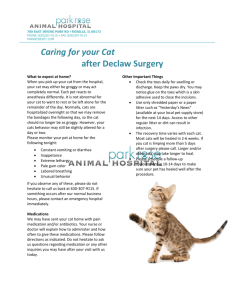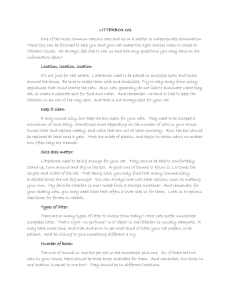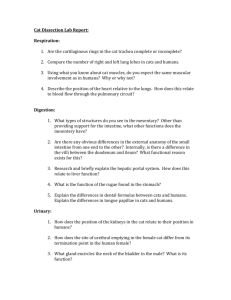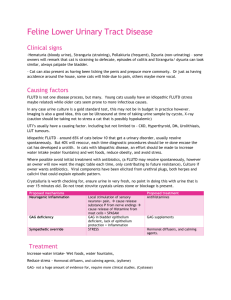Diagnosing and Treating Feline House Soiling Valarie V. Tynes
advertisement
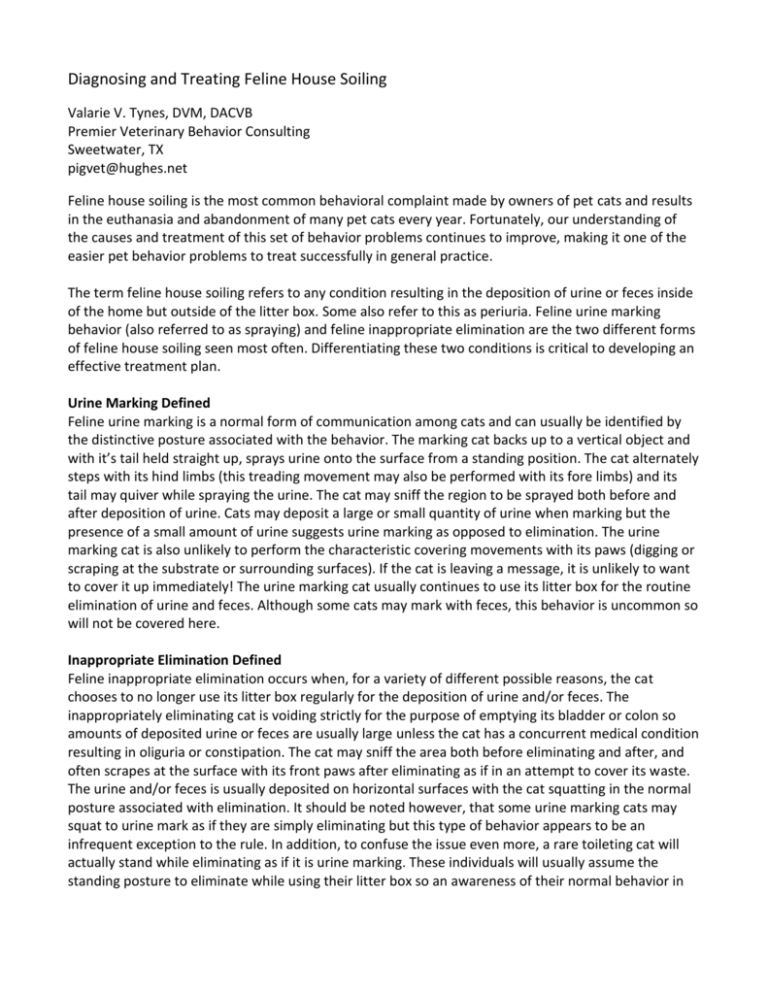
Diagnosing and Treating Feline House Soiling Valarie V. Tynes, DVM, DACVB Premier Veterinary Behavior Consulting Sweetwater, TX pigvet@hughes.net Feline house soiling is the most common behavioral complaint made by owners of pet cats and results in the euthanasia and abandonment of many pet cats every year. Fortunately, our understanding of the causes and treatment of this set of behavior problems continues to improve, making it one of the easier pet behavior problems to treat successfully in general practice. The term feline house soiling refers to any condition resulting in the deposition of urine or feces inside of the home but outside of the litter box. Some also refer to this as periuria. Feline urine marking behavior (also referred to as spraying) and feline inappropriate elimination are the two different forms of feline house soiling seen most often. Differentiating these two conditions is critical to developing an effective treatment plan. Urine Marking Defined Feline urine marking is a normal form of communication among cats and can usually be identified by the distinctive posture associated with the behavior. The marking cat backs up to a vertical object and with it’s tail held straight up, sprays urine onto the surface from a standing position. The cat alternately steps with its hind limbs (this treading movement may also be performed with its fore limbs) and its tail may quiver while spraying the urine. The cat may sniff the region to be sprayed both before and after deposition of urine. Cats may deposit a large or small quantity of urine when marking but the presence of a small amount of urine suggests urine marking as opposed to elimination. The urine marking cat is also unlikely to perform the characteristic covering movements with its paws (digging or scraping at the substrate or surrounding surfaces). If the cat is leaving a message, it is unlikely to want to cover it up immediately! The urine marking cat usually continues to use its litter box for the routine elimination of urine and feces. Although some cats may mark with feces, this behavior is uncommon so will not be covered here. Inappropriate Elimination Defined Feline inappropriate elimination occurs when, for a variety of different possible reasons, the cat chooses to no longer use its litter box regularly for the deposition of urine and/or feces. The inappropriately eliminating cat is voiding strictly for the purpose of emptying its bladder or colon so amounts of deposited urine or feces are usually large unless the cat has a concurrent medical condition resulting in oliguria or constipation. The cat may sniff the area both before eliminating and after, and often scrapes at the surface with its front paws after eliminating as if in an attempt to cover its waste. The urine and/or feces is usually deposited on horizontal surfaces with the cat squatting in the normal posture associated with elimination. It should be noted however, that some urine marking cats may squat to urine mark as if they are simply eliminating but this type of behavior appears to be an infrequent exception to the rule. In addition, to confuse the issue even more, a rare toileting cat will actually stand while eliminating as if it is urine marking. These individuals will usually assume the standing posture to eliminate while using their litter box so an awareness of their normal behavior in the litter box will be very helpful in making a diagnosis. Fortunately, as with the “squatting urine markers”, these cats are the exception, not the norm. These variations exemplify the critical importance of taking a thorough and detailed history. A diagnosis of inappropriate elimination may be further defined by classifying it as a substrate preference, substrate aversion, location preference or location aversion. However, oftentimes, these categories overlap, as with the cat that chooses to eliminate on the carpet because it had a painful lower urinary tract infection. The infection may lead to a location aversion. If the elimination on the carpet occurs often enough, the carpet may become the preferred substrate leading to the substrate preference. Treating the urinary tract disease may not necessarily result in a return to the litter box because the location aversion is still present. How to recognize these different causes of inappropriate elimination will be covered later. Collecting The History Collecting the detailed information necessary to make an accurate diagnosis in cases of feline house soiling can be challenging and time consuming. The use of a written questionnaire will be vital for the average busy practitioner. Fortunately, excellent questionnaires are available in a variety of behavior texts and on line at sites such as www.avsabonline.org. House calls are ultimately the ideal way to evaluate house soiling cats but this is impractical for most practitioners and by no means necessary. In the authors experience the best substitute for a house call is a diagram of the owner’s home. When presented with the questionnaire to complete, the client should also be instructed to draw a simple diagram of their home’s floor plan. They should be instructed to note where food, water bowls and litter boxes are located, as well as all of the soiled locations, favorite resting and play areas and areas where the cat spends the majority of its time. If the owner has access to a video camera and they can capture some video of the cat in its litter box or during the act of house soiling, that can be extremely helpful in confirming the diagnosis and may help to understand the cat’s motivation for house soiling as well. In addition to collecting all of the details about where the cat eliminates, how much is deposited and what the behavior is before and after deposition, I have found that one of the most important diagnostic criteria used to help solve the house soiling mystery is a description of the type of substrate that has been soiled. Cats that are urine marking will mark on virtually any surface; carpet, tile floors, hardwood floors, walls, furniture, appliances, stereo speakers, luggage and even shopping bags. It may mark anything new that is brought into the home, within minutes of its appearance. However, the cat that is eliminating will usually demonstrate a preferred substrate type. These cats most commonly prefer soft, absorbent surfaces and so may eliminate on furniture, bedding, carpeting and clothing that is left on the floor or furniture. These are the cats that for reasons not yet fully understood do not like the litter or box that has been offered to them and prefer other substrates for elimination. Cats that eliminate in bath tubs and sinks are demonstrating a preference for a substrate that has been linked to the presence of feline lower urinary tract disease (FLUTD). It should also be noted that many cats will choose a new location and substrate to urinate on while continuing to use the litter box for defecation. Common Causes of Inappropriate Elimination The likely causes of the two forms of house soiling also differ. FLUTD has been noted as an important cause of inappropriate elimination by many authors. It is hypothesized that pain or discomfort associated with the litter box may lead to a location or even substrate aversion, or that urgency and a frequent need to eliminate may simply make it difficult for the cat to get to the litter box, thus resulting in inappropriate elimination. Ultimately, any medical condition causing pain during elimination or a sense of urgency can lead to inappropriate elimination. These may include but are not limited to; anatomic abnormalities, osteoarthritis, calculi, constipation, diabetes mellitus, diarrhea, feline immunodeficiency virus (FIV), feline infectious peritonitis (FIP), feline leukemia (FeLV), food allergies, hyperthyroidism, inflammatory bowel disease, internal parasites, maldigestion/malabsorbtion and pyelonephritis. A box that is excessively soiled due to diarrhea or polyuria may also lead some cats to look for a more pleasant alternate location. This is very important to keep in mind when dealing with multi-cat households! The cat with the medical condition may not always be the cat that eliminates inappropriately. The healthy cat may be more “finicky” about a clean box and choose an alternate location because a sick house mate is keeping the litter box soiled. Location and even substrate preferences often develop secondary to the aversion caused by a medical problem. Several “triggers” other than medical problems can also be important causes of inappropriate elimination. An agonistic encounter between two cats at the litter box may lead one cat to seek a less stressful place to eliminate. The presence of dogs, children, loud appliances and large amounts of human activity around a litter box may also cause some cats to look for quieter, “safer” places to eliminate. This does not mean the cat is urine marking, the cat has simply chosen a place for elimination that is more satisfactory to the cat. The same scenario may occur if the cat’s litter box is not cleaned appropriately and becomes heavily soiled with urine or feces. The cat may look for a place to eliminate that is cleaner and therefore more pleasant for the cat. Switching types or brands of cat litter can also serve as a trigger for the cat to seek a new preferred place to eliminate. Certain aspects of the litter box itself can also be unpleasant for the cat. Boxes that are covered, too small or difficult to climb into may be rejected by the cat. Some cats may find the presence of plastic liners or additives such as baking soda offensive. Boxes that are old and have become permeated with the scent of urine should be replaced. Using strong smelling cleansers to clean the litter box may cause a lingering odor that cats find offensive. It is easy to confuse many of these scenarios with urine marking but a detailed history and comparison of the diagnostic criteria detailed above should help to differentiate the two. The behavior of the cat that does not like its litter may be quite obvious, thus the importance of having the client observe their cat both in the litter box and during inappropriate elimination if at all possible. The cat that does not like its litter may perch precariously on the sides of the box as if afraid to touch the litter. It may run from the box the minute it is finished eliminating, often without covering. It may also shake its feet vigorously after leaving the box. One study has even demonstrated that cats with inappropriate elimination spend less time digging in their litter than cats without elimination problems. One should also be aware that a medical problem may cause a cat to begin eliminating elsewhere and even after resolution of the problem the cat will continue to use its new preferred location. Therefore, you cannot assume that just because you have successfully treated a medical condition or corrected a problem with a litter box, that the cat will immediately begin to use the box again. The litter box aversion and the preference for the new location may be well established and environmental and behavioral modification will still be necessary. Sometimes, it is impossible to determine exactly what caused a cat to seek a new spot for elimination, but once the cat has found a spot that it prefers, it is likely to continue using it indefinitely unless appropriate treatment is initiated. Determining appropriate treatment is simply easier if one can learn something about what the cat prefers about its new location and dislikes about the location the owners prefer it to use, i.e. the litter box. Common Causes Of Urine Marking At this time, no pathophysiological cause of urine marking has ever been clearly demonstrated. A few studies have been published suggesting an association between a disease process and urine marking but other studies have found no association. The likely causes of urine marking have been clearly documented and are numerous; agonistic interactions with cats outside of the home, agonistic interactions with cats inside the home, changes in the environment (new roommate, new baby, new furniture, relocation, etc.) and even limiting the cats access to the outdoors. This suggests that when gonadectomized cats urine mark, they may be doing so due to stress and their response to anxiolytic drugs contributes further to this hypothesis. When attempting to determine if a cat is urine marking, the practitioner needs to question the owner in detail about the presence of cats outdoors and the behavior of the house soiling cat in relation to other feline house mates. Cats that are the only cat in the household and have never been around other cats may be more distressed about the presence of cats outdoors. Even individuals that coexist peacefully with other cats may be distressed about the presence of strange cats around their home. Owners may be unaware that their cat is experiencing distress about outdoor cats. The owner may simply think their cat is observing the outdoor cat so descriptions of their “body language” should be part of the history. Ask if the cat is staring, if they are standing stiffly or appear to be “frozen”. Does the cat’s tail wag or twitch rapidly back and forth? Does the cat vocalize? These behaviors may suggest that the cat is aggressively aroused and therefore may be more likely to urine mark. Certainly, if the cat observing an outdoor cat turns and hisses or attacks its house mate or a nearby person, then the cat is aggressively aroused about the outdoor cat and may begin urine marking. It may only take one such experience for a cat to begin urine marking. Many owners also have difficulty determining if agonistic interactions are occurring in their multi-cat household. They may think their cats get along fine when in fact relations are very strained. Making this determination can be difficult since cats frequently exhibit what can be called a rather “passive” type of aggression. Information that may be useful includes, determining if the cats sleep together and/or groom one another. Cats that sleep with their bodies contacting each other and groom each other frequently are most likely to have a very good relationship and are less likely to be house soiling due to intercat aggression. Owners simply need to be aware that just because there are no obvious fights occurring, does not mean that the cats are coexisting peacefully. As with the inside cat observing an outdoor cat, they need to watch for staring and stiff body postures. One cat, simply standing in a doorway staring at the other cat may constitute an aggressive encounter that keeps the threatened cat away from the litter box. Details of the diagnosis and treatment of feline intercat aggression problems are beyond the scope of this discussion but have been covered elsewhere. If it appears that intercat aggression between cats within the household is related to the house soiling problem then it needs to be treated as an additional and separate problem at the same time that the other treatments for house soiling are initiated. The effect of a dirty or improperly cleaned litter box should not be ignored when looking for a possible cause of urine marking behavior. One study of urine marking found that both enzymatic cleaning of urine marks and good litter box hygiene in the form of daily scooping of litter, regular cleaning of the box, and provision of enough litter boxes decreased the frequency of urine marking in the household. This effect was more noted in female cats as opposed to male cats. It can be hypothesized that the presence of a dirty litter box is an anxiety provoking situation for a cat, that in some individuals leads to urine marking behavior. An Accurate Diagnosis Is Vital To Treatment Success The importance of collecting and considering all of this information about the cats soiling behavior cannot be overemphasized. Although there are similarities between treatment for inappropriate elimination and house soiling, there are some very important differences. Both types of feline house soiling will usually be treated successfully by employing differing combinations of the following three steps: 1) make the inappropriate locations unpleasant or inaccessible, 2) make the appropriate areas more pleasant and attractive to the cat and 3) decrease the cats motivation to perform the inappropriate behavior. Although the basic concepts are similar for both urine marking and inappropriate elimination, the methods by which you can satisfy the three steps can differ in some very important ways. Treatment of Inappropriate elimination Successful treatment of inappropriate elimination will need to focus primarily on steps 1 and 2. The area that the owner wants the cat to use for toileting must be made more appealing to the cat and the area currently being used for toileting must be made unpleasant or better yet, completely inaccessible to the cat. The methods used to accomplish this will depend somewhat on the number and types of locations that the cat has chosen but successful treatment is far less likely if only one approach is used. For example, if you simply close the door to the room that the cat is eliminating in without also changing the litter, box or location, the cat is likely to simply begin eliminating somewhere else. The client should also be reminded that what works for one cat will not work for every cat and they must be prepared to be methodical and patient in an attempt to determine what works for their individual cat. Making The Litter Box More Appealing It may be easier to find ways to make the toileting area more appealing if you have some idea as to what may have initially caused the cat to seek alternate toileting areas. Try to determine if you are dealing with a litter or location aversion or a substrate or location preference or a combination of these. Improving the toileting area may therefore include changing the litter box location, adding one or more litter boxes and even offering a “litter cafeteria” in order to determine if the cat has a preference for a particular type of litter. “Litter cafeterias” play a very important role in treating the cat who dislikes the feel of the litter in the box. When preparing a litter cafeteria it must be emphasized to the client that they need to test one aspect of the litter box at a time. In other words, if it has been determined that the cat doesn’t like something about the litter then 2-3 identical litter boxes need to be placed side by side, each with an different litter inside. If you suspect that it is some aspect of the box that the cat doesn’t like then you choose 2-3 different types or sizes of box and place them side by side each containing the identical litter. It should also be noted that in a study of feline litter preferences, cats were shown to prefer fine, sandy, clumping type litters over other litters so a clumping type of litter should always be at least one of the types offered in a “litter cafeteria”. There is also some anecdotal evidence suggesting that cats do not like covered boxes so when testing preferences with a “litter cafeteria”, uncovered boxes should be offered initially. When offering the litter box cafeteria the client should be instructed to keep good notes as to which litter or box the cat uses over a several week period. They should be warned that at the beginning of the test, many cats will use whichever box or litter is new simply because of the novelty. It will take a while for the cat’s ultimate preference to be made clear. There is much anecdotal evidence to suggest that many cats find their litter box too small and uncomfortable to access. Offering a box that is substantially bigger than the one currently offered to the cat has successfully treated many cases of inappropriate elimination in my experience. Large, plastic containers such as those used for under bed storage or mixing concrete have all been used and found preferable by some cats to the typical box marketed as a “litter box” by pet stores. Many cats quit using a litter box because it is in an area of the house where there is a lot of foot traffic or noise. Children playing, dogs lurking, the presence of other cats in or around the box and noisy washing machines have all been found to keep some cats away from their litter box. Clients should be reminded that the litter box needs to be in a quiet but easily accessible location. Cats forced to climb stairs or go to a remote part of a large home have also been known to choose alternate locations. The litter box provided for the aging cat should be given special attention. There may need to be multiple litter box locations. The box may need to be shallower than when the cat was younger so that it is easy to climb in and out of. Even the act of having to climb one or two steps or step up and out of a cat door has been known to be too uncomfortable for some older cats and led to their choosing an alternate location. Making the area that the owner wants the cat to use for toileting more appealing must also include improving litter hygiene by scooping routinely and completely emptying the box regularly. Harsh disinfectant chemicals such as pine based cleansers and bleach should be avoided as many cats appear to find the lingering smell aversive. Litter boxes should be cleaned with hot water and a mild detergent soap, then rinsed and allowed to air dry. Old plastic boxes that are permeated with the odor of urine, should be disposed of and replaced rather than attempting to clean them with stronger cleansers. Plastic liners and litter additives such as baking soda and other deodorants should be avoided. A general “rule of thumb” for multi cat households has always been to provide a litter box for every cat plus one. It should be remembered that this is just a “rule of thumb”. Some households, especially those with some intercat aggression may need more than that. Some single cat households may also need more than one box. For example, the household with the aging cat, as noted above, or a cat with a medical condition that leads to urgency or frequent elimination may need several boxes in easy to access locations. Again, the goal is to make the litter box a very convenient and comfortable place to eliminate for the cat. Treating the individual that has had pain or discomfort associated with elimination may require making dramatic changes such as providing a completely new box with completely different litter and possibly even putting it in the location that the cat has chosen for toileting. The pet owner will also need to be informed that any recurrences of the health problem may also lead to a recurrence of the behavior problem. They should be prepared to act quickly in that event to institute changes so that they may possibly prevent an aversion and subsequent preference for a new toileting area from developing again. Once a cat has learned that it can find and readily use alternate locations for elimination, it is more likely to repeat that behavior any time in the future when the box becomes uncomfortable or associated with an unpleasant experience. Making The Inappropriate Area Less Appealing Or Inaccessible The first step in changing the appeal of the area that the cat has chosen for toileting must include thorough cleaning of the area with an enzymatic cleaner so that the olfactory cues attracting the cat back to the area are removed. Alternatively, the “litter cafeteria” can be placed in the location and once the cat finds a litter that it likes, the owner can very slowly, over a several day period, move the box to the location that they prefer. Of course, it is imperative that the location chosen by the cat owner be a place in which the cat feels safe and secure! If there are numerous soiled areas, it may be more practical to simply make them unappealing or inaccessible. This can be as simple as closing doors to rooms where the cat eliminates, to more complicated solutions such as booby traps. Simply covering the area with aluminum foil, plastic or double sided tape will discourage some cats. Others require something a little more unpleasant such as plastic carpet protectors placed upside down. There are also numerous “high tech” devices available through pet suppliers. These include remote control devices that make a noise or spray citronella, snappy trainers, and scat mats. Again, the owner will need to be reminded that what works for one cat may not work for another. I have seen some cats walk across the upside down carpet protectors by simply placing their feet between the spikes! Other cats will never return to an area after being startled by citronella once! Finding what works for each cat takes some persistence. Decreasing The Cats Motivation For Performing The Inappropriate Behavior While this plays a lesser role in the treatment of inappropriate elimination some cats will be less motivated to use a certain location if their association with the area is changed. For example, if the cat has only soiled one or two small areas, depending on where they are in the home, the owner can also choose to feed and water the cat there. This may help to change the cats association with the area from that of an elimination are to a feeding area. Another option is to place favorite toys, beds or “cat trees” in the location that the cat has chosen for elimination. Playing with the cat in this location, can also help to change the cat’s association with the area. In a rare case, where anxiety is involved, psychotropic medications may help to decrease a cats motivation for inappropriate elimination. In most cases, it will not play a role. If inter-cat aggression is contributing to the problem, one or both of the cats involved may need to be medicated. In that case, the aggression will need to be evaluated and treated as a separate problem. Urine Marking Decreasing The Cats Motivation To Perform The Inappropriate Behavior Step three is the most important aspect of treating urine marking. The cats motivation for performing the inappropriate behavior, can almost always be decreased with the use of psychotropic medications Research has found pharmacological treatment of urine marking to be very effective. Both fluoxetine (Prozac) at a dose of 1 mg/kg q 24 hours and Clomiprmaine at 0.5-1 mg/kg q 24 hours have been found to be similarly effective in the treatment of urine marking. Adverse events associated with the use of either clomipramine or fluoxetine are usually mild, appear to be dose related and are usually reversible with discontinuation of the drug. They include changes in appetite (anorexia), sedation, urine retention, constipation and vomiting. Most studies have also demonstrated a return to urine marking after drug discontinuation so clients should be prepared to continue drug treatment indefinitely unless triggers for urine marking can be confirmed and permanently corrected. If owners are reluctant to use psychotropic medications or are simply unable to medicate their cat then other means of decreasing the cat’s motivation to mark will need to be sought. Owners should attempt to determine what the triggers are for urine marking and when possible, eliminate those triggers. For example, if the presence of cats outdoors leads to urine marking, window shades can be kept closed, furniture rearranged and window perches removed so that the marking cat cannot easily see outdoor cats. Remote control water sprinklers and similar devices outside can also be used to keep stray cats away from the home. If agonistic encounters between cats within the home are an inciting cause, then the inter-cat aggression issues need to be treated so as to try to improve the relationship between the cats. However, the provision of multiple feeding sites, watering sites, litter boxes, hide areas and multilevel perching sites can all help indoor cats avoid each other where possible, thus decreasing the frequency of agonistic encounters. Pheromones are another “tool” that can be used to decrease a cats’ anxiety and thus decrease their motivation for urine marking. Feliway is a synthetic analogue of feline cheek gland pheromones. The cat is believed to use its facial pheromones as a mark in the environment, similar to urine, and this marking may serve to make them feel more comfortable or familiar with their environment. Different studies have found that the use of the pheromone can decrease spraying in a household by 74-91%. Even if the results may be less impressive than those gained by using fluoxetine or clomipramine, pheromone sprays are an excellent adjunct therapy and may serve as an alternative for cat owners whose cats are difficult to medicate, in households where the urine marking culprit is difficult to identify, or for pet owners who for a variety of reasons decline to use psychotropic medications in their pets. Steps 1 and 2, as listed above, play a lesser role in treating the urine marking cat. However, environmental management for urine marking cats should not be ignored. Making the targeted spots less appealing or inaccessible and improving the appeal of the litter box all play a role. All old urine marks need to be identified and cleaned with enzymatic cleaner. Good litter box hygiene in the form of daily scooping of litter, regular cleaning of the box, and provision of enough litter boxes has been shown to decrease urine marking behavior in some cats.
